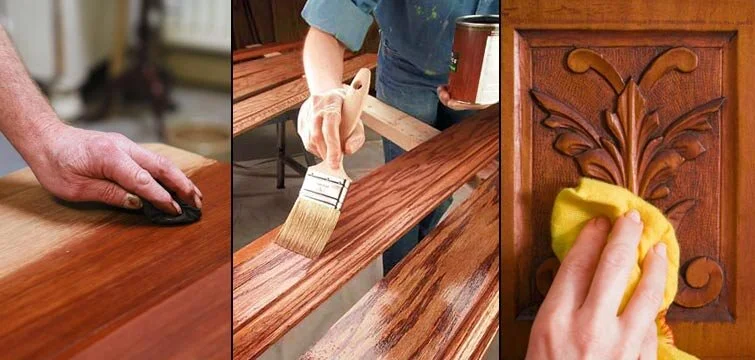Common Wood Polishing Mistakes and How to Avoid Them
Wood Polishing Abu Dhabi is an essential part of maintaining the beauty and longevity of furniture, floors, and other wooden surfaces. However, many people encounter challenges along the way, leading to unsatisfactory results or even damage to the wood. In this blog, we’ll explore some common wood polishing mistakes and provide tips on how to avoid them, ensuring a stunning finish that enhances the natural beauty of your wood.
1.
Skipping Surface Preparation
Mistake: One of the biggest mistakes people
make is not properly preparing the wood surface before polishing. This can lead
to a rough finish and uneven sheen.
Solution: Always start by cleaning the wood
surface thoroughly to remove dust, dirt, and grease. Use a soft cloth and a
mild cleaning solution if necessary. If the wood is previously finished, sand
it lightly with fine-grit sandpaper to create a smooth surface and help the
polish adhere better. Make sure to wipe away any dust created during sanding.
2. Using
the Wrong Polish
Mistake: Choosing the wrong type of polish can
result in poor adhesion, uneven shine, or even damage to the wood.
Solution: Understand the type of wood and its
finish before selecting a polish. For instance, avoid oil-based polishes on
water-based finishes, as they can lead to discoloration. Always test the polish
on a small, inconspicuous area first to see how it reacts with the wood.
3.
Applying Too Much Polish
Mistake: Overapplying polish is a common error
that can create a sticky, greasy residue and result in an unattractive finish.
Solution: Less is often more when it comes to
polishing. Use a small amount of polish and apply it with a soft, lint-free
cloth. Work in small sections and buff the polish into the wood in circular
motions. If you notice excess polish building up, wipe it off immediately with
a clean cloth.
4. Not
Allowing Enough Drying Time
Mistake: Rushing the drying process can lead
to smudging and uneven finishes. People often apply multiple coats of polish
without allowing sufficient drying time between applications.
Solution: Follow the manufacturer’s
instructions regarding drying times. Typically, it’s best to wait at least 10
to 30 minutes between coats, depending on the product. Patience during the
drying process will yield a more durable and attractive finish.
5. Failing
to Buff Properly
Mistake: Insufficient buffing or polishing can
leave a dull or uneven surface. Conversely, buffing too aggressively can
scratch the wood.
Solution: After applying the polish, use a
clean, soft cloth to buff the surface gently. Buff in circular motions,
applying just enough pressure to create a sheen without damaging the wood. For
larger surfaces, consider using a buffer or a polishing machine designed for
wood.
6.
Ignoring the Grain Direction
Mistake: Polishing against the grain can cause
scratches and a less appealing finish, especially on softer woods.
Solution: Always polish in the direction of the
wood grain. This technique helps achieve a smoother finish and enhances the
natural beauty of the wood. If you’re unsure of the grain direction, examine
the surface closely, or run your hand over it to feel the texture.
7.
Neglecting Regular Maintenance
Mistake: Many people think of polishing as a
one-time task, forgetting that regular maintenance is essential for wood care.
Solution: Create a maintenance schedule that
includes regular dusting and polishing. Depending on the usage and type of
wood, polishing every few months can keep your wood looking its best. This not
only enhances the appearance but also protects the wood from damage over time.
8.
Overlooking Environmental Conditions
Mistake: Failing to consider the temperature
and humidity levels in the area can negatively impact the polishing process.
Solution: Aim to polish wood in a controlled
environment. Avoid polishing in extreme temperatures or high humidity, as this
can affect drying times and the final finish. Ideally, work in a space that is
well-ventilated, with a moderate temperature and low humidity levels.
9. Using
Abrasive Materials
Mistake: Using abrasive pads or harsh
scrubbers can scratch and damage the wood surface.
Solution: Always opt for soft, non-abrasive
cloths for polishing. Microfiber cloths are an excellent choice as they are
gentle on surfaces and effective in applying and buffing polish. Avoid steel
wool or abrasive sponges, especially on softer woods.
10.
Forgetting to Protect Surrounding Areas
Mistake: Neglecting to protect surrounding
surfaces can lead to polish drips, smudges, or damage to adjacent areas.
Solution: Before you begin polishing, lay down
drop cloths or newspapers to protect the surrounding area. If working on
furniture, consider moving it to an area where spills or drips won’t cause
damage, or cover nearby surfaces with plastic or cloth.
Conclusion:
Achieving a Beautiful Finish
Wood Polishing
Abu Dhabi can be a rewarding task, enhancing the beauty and lifespan of
your furniture and wooden surfaces. By avoiding these common mistakes and
following the tips outlined in this blog, you can achieve a stunning finish
that showcases the natural elegance of wood. With a little patience and the
right techniques, your wood will shine beautifully for years to come. Happy
polishing!



Comments
Post a Comment